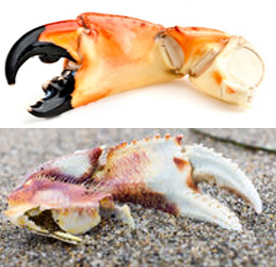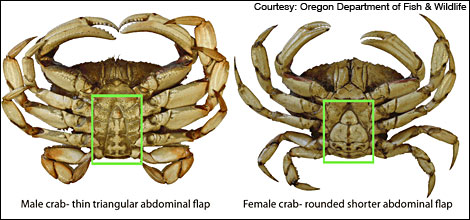White-Tipped Pincers
- Most crabs in the family Cancer have black-tipped pincers, but only two species have white-tipped pincers: the Dungeness crab and the Slender crab.

Dungeness crabs are invertebrates, meaning that they have no internal skeleton or backbone. They are the most abundant crab in California, but are most prevalent in the Northern waters above Monterey. A typical lifespan is 8-13 years, reaching a size of 10 inches or larger.
Due to their hard outer shell, they have a unique growth process that requires them to shed their shell. This process, called molting, happens every year, and allows the crab to shed the old shell and reveal a new, larger shell.
The carapace (outer shell) of this species is typically light reddish-brown on the top with a cream colored underside. Occasionally carapaces can have purple coloring on the top side as well. The four pairs of legs are typically the same color as the carapace, and are used to move the crab by pushing with the legs on one side and pulling with the other side to walk sideways. The two front pincers are white-tipped, and help the crab grasp, tear, and defend.
How to Determine the Gender of a Dungeness Crab

Diet & Habitat
Juvenile crabs prefer to live in cooler waters and hide among or beneath rocks, eelgrass, or debris in the intertidal or shallow subtidal zones while adult crabs live among eelgrass beds and on sandy or muddy substrate. This species usually mates nearshore and the female travels to deeper waters in order to hatch her eggs. The Dungeness Crab is a forager, and will roam the sea floor and eat small organisms that bury themselves partly or completely in the sand. These organisms vary in type because crabs will eat whatever food-source is available, making them opportunistic predators. Since they are carnivores, a few common prey include worms, clams, smaller crabs, shrimp, and mussels.
Crabbing:
Click here to see a video of crabbing in action
